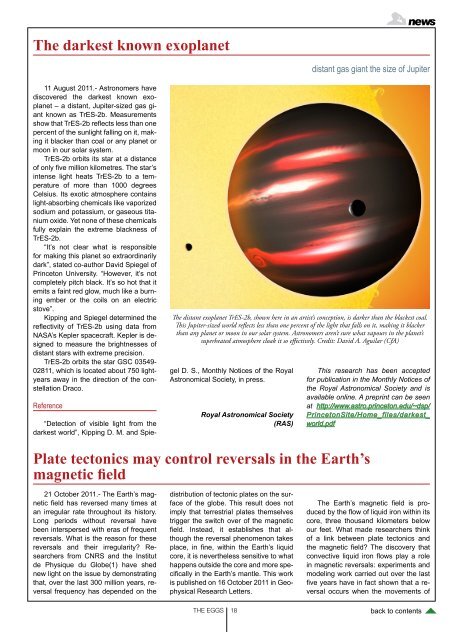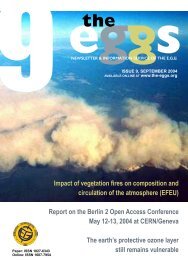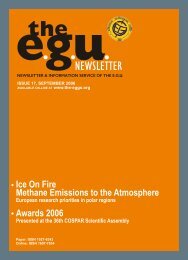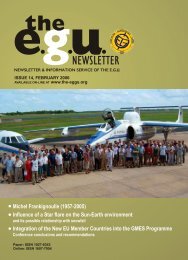Air Quality and Climate in Megacities and Regional Hot Spots
Air Quality and Climate in Megacities and Regional Hot Spots
Air Quality and Climate in Megacities and Regional Hot Spots
You also want an ePaper? Increase the reach of your titles
YUMPU automatically turns print PDFs into web optimized ePapers that Google loves.
The darkest known exoplanetdistant gas giant the size of Jupiter11 August 2011.- Astronomers havediscovered the darkest known exoplanet– a distant, Jupiter-sized gas giantknown as TrES-2b. Measurementsshow that TrES-2b reflects less than onepercent of the sunlight fall<strong>in</strong>g on it, mak<strong>in</strong>git blacker than coal or any planet ormoon <strong>in</strong> our solar system.TrES-2b orbits its star at a distanceof only five million kilometres. The star’s<strong>in</strong>tense light heats TrES-2b to a temperatureof more than 1000 degreesCelsius. Its exotic atmosphere conta<strong>in</strong>slight-absorb<strong>in</strong>g chemicals like vaporizedsodium <strong>and</strong> potassium, or gaseous titaniumoxide. Yet none of these chemicalsfully expla<strong>in</strong> the extreme blackness ofTrES-2b.“It’s not clear what is responsiblefor mak<strong>in</strong>g this planet so extraord<strong>in</strong>arilydark”, stated co-author David Spiegel ofPr<strong>in</strong>ceton University. “However, it’s notcompletely pitch black. It’s so hot that itemits a fa<strong>in</strong>t red glow, much like a burn<strong>in</strong>gember or the coils on an electricstove”.Kipp<strong>in</strong>g <strong>and</strong> Spiegel determ<strong>in</strong>ed thereflectivity of TrES-2b us<strong>in</strong>g data fromNASA’s Kepler spacecraft. Kepler is designedto measure the brightnesses ofdistant stars with extreme precision.TrES-2b orbits the star GSC 03549-02811, which is located about 750 lightyearsaway <strong>in</strong> the direction of the constellationDraco.ReferenceThe distant exoplanet TrES-2b, shown here <strong>in</strong> an artist’s conception, is darker than the blackest coal.This Jupiter-sized world reflects less than one percent of the light that falls on it, mak<strong>in</strong>g it blackerthan any planet or moon <strong>in</strong> our solar system. Astronomers aren’t sure what vapours <strong>in</strong> the planet’ssuperheated atmosphere cloak it so effectively. Credit: David A. Aguilar (CfA)“Detection of visible light from thedarkest world”, Kipp<strong>in</strong>g D. M. <strong>and</strong> SpiegelD. S., Monthly Notices of the RoyalAstronomical Society, <strong>in</strong> press.Royal Astronomical Society(RAS)This research has been acceptedfor publication <strong>in</strong> the Monthly Notices ofthe Royal Astronomical Society <strong>and</strong> isavailable onl<strong>in</strong>e. A prepr<strong>in</strong>t can be seenat http://www.astro.pr<strong>in</strong>ceton.edu/~dsp/Pr<strong>in</strong>cetonSite/Home_files/darkest_world.pdfPlate tectonics may control reversals <strong>in</strong> the Earth’smagnetic field21 October 2011.- The Earth’s magneticfield has reversed many times atan irregular rate throughout its history.Long periods without reversal havebeen <strong>in</strong>terspersed with eras of frequentreversals. What is the reason for thesereversals <strong>and</strong> their irregularity? Researchersfrom CNRS <strong>and</strong> the Institutde Physique du Globe(1) have shednew light on the issue by demonstrat<strong>in</strong>gthat, over the last 300 million years, reversalfrequency has depended on thedistribution of tectonic plates on the surfaceof the globe. This result does notimply that terrestrial plates themselvestrigger the switch over of the magneticfield. Instead, it establishes that althoughthe reversal phenomenon takesplace, <strong>in</strong> f<strong>in</strong>e, with<strong>in</strong> the Earth’s liquidcore, it is nevertheless sensitive to whathappens outside the core <strong>and</strong> more specifically<strong>in</strong> the Earth’s mantle. This workis published on 16 October 2011 <strong>in</strong> GeophysicalResearch Letters.The Earth’s magnetic field is producedby the flow of liquid iron with<strong>in</strong> itscore, three thous<strong>and</strong> kilometers belowour feet. What made researchers th<strong>in</strong>kof a l<strong>in</strong>k between plate tectonics <strong>and</strong>the magnetic field? The discovery thatconvective liquid iron flows play a role<strong>in</strong> magnetic reversals: experiments <strong>and</strong>model<strong>in</strong>g work carried out over the lastfive years have <strong>in</strong> fact shown that a reversaloccurs when the movements ofTHE EGGS 18 back to contents





